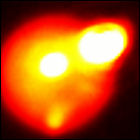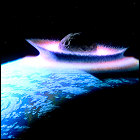Mega-eruption on Io
 Astronomers using the Keck Observatory’s Hawaii-based telescopes and near-infrared cameras capture an image of a devastating volcanic eruption on Io, one of Jupiter’s largest moons (and known since 1979 to be very volcanically active). The eruption, unleashing enough molten material to reshape hundreds of square miles of Io’s surface, also reveals that the material erupted is hotter than any eruption in Earth’s recorded history. This is the most violent eruption seen to date in the solar system, and caps off two weeks of intense activity observed by the astronomers.
Astronomers using the Keck Observatory’s Hawaii-based telescopes and near-infrared cameras capture an image of a devastating volcanic eruption on Io, one of Jupiter’s largest moons (and known since 1979 to be very volcanically active). The eruption, unleashing enough molten material to reshape hundreds of square miles of Io’s surface, also reveals that the material erupted is hotter than any eruption in Earth’s recorded history. This is the most violent eruption seen to date in the solar system, and caps off two weeks of intense activity observed by the astronomers.
The Chicxulub Crater Theory
 In the journal Science, in an article titled “Extraterrestrial Cause for the Cretaceous-Tertiary Extinction”, Nobel-Prize-winning physicist Luis Alvarez and his son, geologist Walter Alvarez, propose their theory that the 110-mile-wide Chicxulub Crater discovered in the past few decades on the northern tip of the Yucatan Peninsula in Mexico is evidence of a large asteroid collision with Earth, resulting in the widespread death of the dinosaurs 65 million years before the modern day. A contentious peer review of the published theory follows, with many opposing theories proposed, though the Chicxulub hypothesis is eventually accepted as the “smoking gun” that killed the dinosaurs (the theory of an asteroid collision with Earth causing the extinction had been in circulation since the 1950s; the Alvarez theory is the first to point to a specific geological feature as evidence).
In the journal Science, in an article titled “Extraterrestrial Cause for the Cretaceous-Tertiary Extinction”, Nobel-Prize-winning physicist Luis Alvarez and his son, geologist Walter Alvarez, propose their theory that the 110-mile-wide Chicxulub Crater discovered in the past few decades on the northern tip of the Yucatan Peninsula in Mexico is evidence of a large asteroid collision with Earth, resulting in the widespread death of the dinosaurs 65 million years before the modern day. A contentious peer review of the published theory follows, with many opposing theories proposed, though the Chicxulub hypothesis is eventually accepted as the “smoking gun” that killed the dinosaurs (the theory of an asteroid collision with Earth causing the extinction had been in circulation since the 1950s; the Alvarez theory is the first to point to a specific geological feature as evidence).
Mt. St. Helens explodes
 Folllowing a lull in its recent frequent earthquake and minor volcanic activity, the summit of Mt. St. Helens in Washington disappears in a massive landslide, releasing a powerful (300mph) lateral explosion that flattens nearby forest land ahead of a devastating release of debris and snowmelt mud known as a lahar. Within an hour, with the summit crater exposed, the remaining magma stored under Mt. St. Helens surges upward, resulting in a massive eruption from the summit, lasting nine hours and wiping out hundreds of square miles of forest and killing dozens of people, including geologists who had been on station to monitor the volcano’s activity. Following the eruption, Mt. St. Helens is over 1,000 feet shorter, its peak replaced by a mile-wide crater. This is the first significant volcanic eruption on the American mainland since 1915.
Folllowing a lull in its recent frequent earthquake and minor volcanic activity, the summit of Mt. St. Helens in Washington disappears in a massive landslide, releasing a powerful (300mph) lateral explosion that flattens nearby forest land ahead of a devastating release of debris and snowmelt mud known as a lahar. Within an hour, with the summit crater exposed, the remaining magma stored under Mt. St. Helens surges upward, resulting in a massive eruption from the summit, lasting nine hours and wiping out hundreds of square miles of forest and killing dozens of people, including geologists who had been on station to monitor the volcano’s activity. Following the eruption, Mt. St. Helens is over 1,000 feet shorter, its peak replaced by a mile-wide crater. This is the first significant volcanic eruption on the American mainland since 1915.
Mt. St. Helens awakens
 Following eleven days of precursory earthquake activity, Mt. St. Helens, a volcano in Washington which has been dormant for over a century, emits a small eruption of ash and steam. Similar eruptions continue on an hourly basis, though the frequency will gradually diminsh through April. This activity lasts barely a month before ending, at least for a week or two. The north face of Mt. St. Helens begins bulging noticeably, and emergency planners fight to keep sightseers away from the mountain while drawing up evacuation plans for nearby populated areas. Some locals vow to remain despite possible evacuation orders.
Following eleven days of precursory earthquake activity, Mt. St. Helens, a volcano in Washington which has been dormant for over a century, emits a small eruption of ash and steam. Similar eruptions continue on an hourly basis, though the frequency will gradually diminsh through April. This activity lasts barely a month before ending, at least for a week or two. The north face of Mt. St. Helens begins bulging noticeably, and emergency planners fight to keep sightseers away from the mountain while drawing up evacuation plans for nearby populated areas. Some locals vow to remain despite possible evacuation orders.
The fire fountains of Surtsey
 Now nearly five months old, the volcanic island of Surtsey, still erupting and building up from the seafloor off the southern coast of Iceland, transitions to a new phase of its eruption. The explosive eruptions, caused by hot magma coming into direct contact with seawater, subside as the volcanic vents are now permanently above sea level. Almost a mile in diameter, Surtsey’s eruptions transition to lava fountains and lava flows, which harden as they are cooled by the coastal water. This harder material helps to protect Surtsey from being eroded away, and eruptions will continue to add more land area to Surtsey through 1965. Surtsey is almost ready for brief visits from human researchers, who will find life taking root on the island much sooner than expected.
Now nearly five months old, the volcanic island of Surtsey, still erupting and building up from the seafloor off the southern coast of Iceland, transitions to a new phase of its eruption. The explosive eruptions, caused by hot magma coming into direct contact with seawater, subside as the volcanic vents are now permanently above sea level. Almost a mile in diameter, Surtsey’s eruptions transition to lava fountains and lava flows, which harden as they are cooled by the coastal water. This harder material helps to protect Surtsey from being eroded away, and eruptions will continue to add more land area to Surtsey through 1965. Surtsey is almost ready for brief visits from human researchers, who will find life taking root on the island much sooner than expected.
Surtsey
 An Icelandic fishing vessel investigates a column of smoke almost 30 miles off of Iceland’s southern coast, with the crew believing it to be another boat in distress. What the crew finds, however, is a new volcanic island poking out of the sea – a submarine eruption that has now broken the surface of the Atlantic. A column of airborne ash and gas rises miles into the air, and within a weak vigorous eruptions create a new island over 1500 feet long, rising 147 feet above sea level. The eruption continues violently, adding more land area to the island but keeping scientists (and sightseers) at bay. The island is named Surtsey after a figure in Norse mythology.
An Icelandic fishing vessel investigates a column of smoke almost 30 miles off of Iceland’s southern coast, with the crew believing it to be another boat in distress. What the crew finds, however, is a new volcanic island poking out of the sea – a submarine eruption that has now broken the surface of the Atlantic. A column of airborne ash and gas rises miles into the air, and within a weak vigorous eruptions create a new island over 1500 feet long, rising 147 feet above sea level. The eruption continues violently, adding more land area to the island but keeping scientists (and sightseers) at bay. The island is named Surtsey after a figure in Norse mythology.